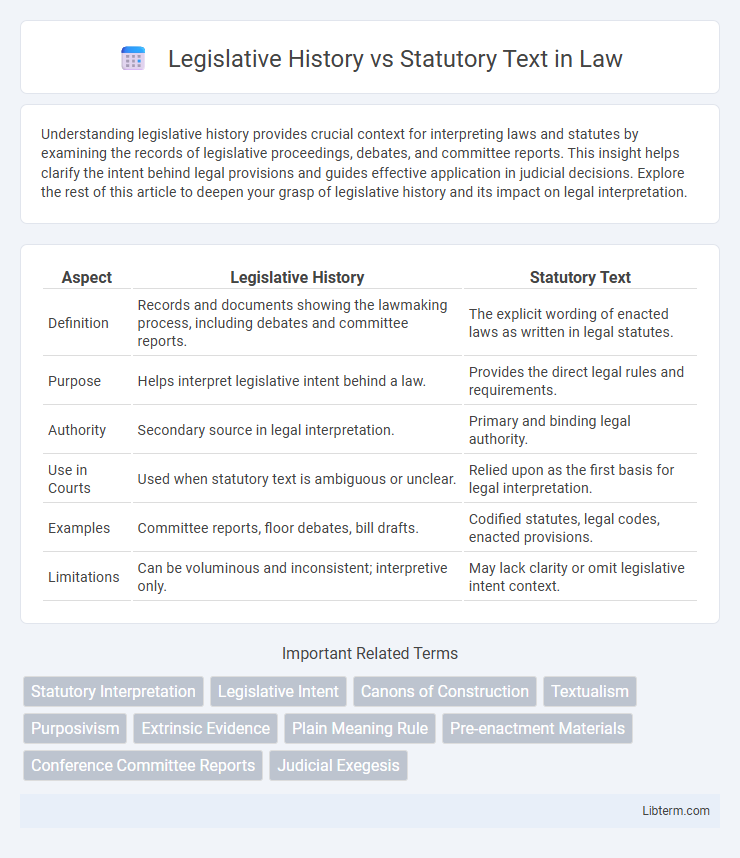Understanding legislative history provides crucial context for interpreting laws and statutes by examining the records of legislative proceedings, debates, and committee reports. This insight helps clarify the intent behind legal provisions and guides effective application in judicial decisions. Explore the rest of this article to deepen your grasp of legislative history and its impact on legal interpretation.
Table of Comparison
| Aspect | Legislative History | Statutory Text |
|---|---|---|
| Definition | Records and documents showing the lawmaking process, including debates and committee reports. | The explicit wording of enacted laws as written in legal statutes. |
| Purpose | Helps interpret legislative intent behind a law. | Provides the direct legal rules and requirements. |
| Authority | Secondary source in legal interpretation. | Primary and binding legal authority. |
| Use in Courts | Used when statutory text is ambiguous or unclear. | Relied upon as the first basis for legal interpretation. |
| Examples | Committee reports, floor debates, bill drafts. | Codified statutes, legal codes, enacted provisions. |
| Limitations | Can be voluminous and inconsistent; interpretive only. | May lack clarity or omit legislative intent context. |
Introduction to Legislative History and Statutory Text
Legislative history encompasses documents and records created during the lawmaking process, such as committee reports, floor debates, and sponsor statements, providing context and lawmakers' intent behind statutory provisions. Statutory text refers to the actual language of the enacted law, serving as the primary source for legal interpretation and application. Understanding both the legislative history and statutory text ensures a comprehensive analysis of legal statutes, aiding courts and legal professionals in resolving ambiguities and clarifying legislative intent.
Defining Legislative History
Legislative history refers to the collection of documents produced during the creation of a statute, including committee reports, congressional debates, and draft bills, which help interpret legislative intent. Defining legislative history involves analyzing these records to clarify ambiguous statutory provisions or understand the law's purpose beyond its plain text. This approach contrasts with relying solely on the statutory text, emphasizing context from the legislative process to guide judicial interpretation.
Understanding Statutory Text
Understanding statutory text requires analyzing the precise language and syntax used in legislative documents, as courts primarily rely on the text's plain meaning to interpret laws. Statutory text includes definitions, structure, and context within the statute, which guides legal interpretation without heavily depending on legislative history. Emphasizing the statutory text ensures clarity, predictability, and adherence to the law's original intent as expressed through its written provisions.
Importance in Legal Interpretation
Legislative history provides insight into the intent and purpose behind a law through committee reports, debates, and drafts, serving as a crucial tool when the statutory text is ambiguous or unclear. Statutory text remains the primary source of legal authority, emphasizing the precise wording enacted by the legislature, which courts must interpret according to established canons of construction. Understanding both legislative history and statutory text enhances judicial interpretation, ensuring laws are applied consistent with legislative intent and textual clarity.
Advantages of Relying on Legislative History
Relying on legislative history provides deeper insights into lawmakers' intent, offering context that statutory text alone may not clearly convey. It allows courts and legal practitioners to clarify ambiguous language by examining committee reports, debates, and sponsor statements. This approach enhances interpretation accuracy, especially in complex or evolving legal areas where statutory text might be too broad or outdated.
Benefits of Focusing on Statutory Text
Focusing on statutory text provides clarity and predictability by relying on the exact language enacted by the legislature, reducing ambiguity in legal interpretation. Courts prioritize the plain meaning of statutory text, which promotes consistency in applying laws across different cases. This approach minimizes the risk of judicial overreach and ensures adherence to democratic principles by respecting the text as the primary source of legislative intent.
Challenges and Criticisms of Legislative History
Legislative history faces significant challenges due to its often ambiguous and incomplete nature, making it difficult to ascertain the legislature's precise intent. Critics argue that reliance on legislative history can lead to judicial subjectivity and inconsistency, as courts may selectively interpret debates, committee reports, or sponsor statements. This complexity undermines the predictability and clarity that statutory text analysis aims to provide.
Limitations of Statutory Text Analysis
Statutory text analysis often faces limitations due to ambiguous language and the inability to capture legislative intent fully, leading to interpretative challenges. The text alone may not address complex legal contexts or evolving societal norms, resulting in rigid application that fails to reflect lawmakers' original purposes. Reliance solely on statutory text risks overlooking critical insights from legislative history, including committee reports, floor debates, and amendment records.
Judicial Approaches: Balancing Both Tools
Judicial approaches to interpreting legislation carefully balance legislative history with statutory text, emphasizing clear statutory language as the primary authority while using legislative history to resolve ambiguities. Courts prioritize the plain meaning of statutory text but consult committee reports, floor debates, and sponsor statements to understand legislative intent when the text is unclear or leads to absurd results. This dual reliance ensures that statutory interpretation remains faithful to enacted law while benefiting from the contextual insights legislative history provides.
Practical Implications for Legal Professionals
Understanding the distinction between legislative history and statutory text is crucial for legal professionals when interpreting laws. Statutory text provides the authoritative language enacted by the legislature, serving as the primary source for legal interpretation, while legislative history offers supplementary materials such as committee reports and floor debates that can illuminate legislative intent. Relying on statutory text promotes consistency and predictability in legal decisions, but legislative history is invaluable for resolving ambiguities or clarifying congressional purpose during complex litigation.
Legislative History Infographic

 libterm.com
libterm.com